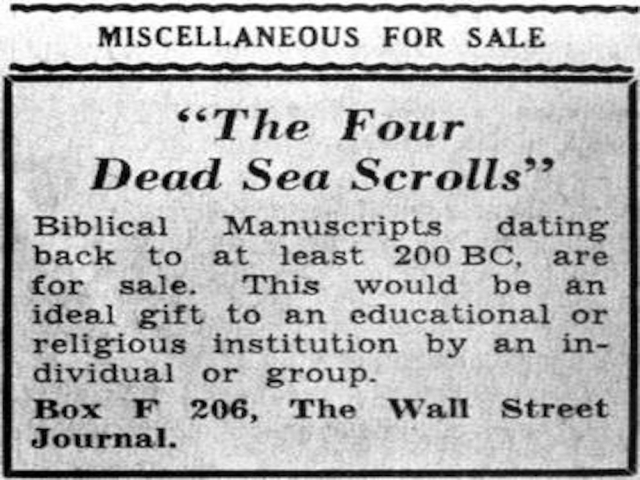On February 13th, 1955, Prime Minister Moshe Sharett held a news conference in which he announced that Israel purchased four out of the first seven Dead Sea Scrolls discovered in a cave at Qumran. The scrolls were placed up for sale in a classified ad placed in the Wall Street Journal by a Syrian Orthodox priest.
Israel Defense Forces Chief of Staff Yigael Yadin and another Hebrew University faculty member arranged the purchase for a hefty $250,000 back in June of 1954 while on a visit to New York; the scrolls were at the time property of the Syrian Orthodox Church. The Hebrew-written scrolls had great historic importance and contained much information not previously known about the late Second Temple writing techniques, along with aiding the Jewish people further solidify their deep-rooted connection to the land of Israel.
1/ The Dead Sea Scrolls were a series of scrolls discovered in the area around Qumran, near the Dead Sea, by a Bedouin shepherd in 1947. pic.twitter.com/xDCNKJf6Ud
— Today in Israel's History (@TodayIsrael) February 13, 2020
The Dead Sea Scrolls are the oldest surviving copies of portions of the Hebrew Bible and currently serve as the main base for understanding the political and cultural daily lives of those who inhabited the region around 2,000 years ago. Prime Minister Sharett said also announced that the scrolls would be preserved in a facility that was being built specifically for them, later known as the Shrine of the Book which is now part of the Israel Museum in Jerusalem.
Estimated to be written between the third century BC and the first century AD, the first seven scrolls were rediscovered by Bedouin shepherds of the Ta’amra tribe in 1946, just a couple of years before Israeli independence. The pieces of parchment were found in clay jars that helped preserve them, along with the dry and salty climate of the Dead Sea.
This month 1955 Israel acquired 4 of the 7 Dead Sea scrolls. Between 1947 & 1956 thousands of fragments of biblical & early Jewish documents were discovered in eleven caves near the site of Khirbet Qumran, illuminated the general cultural & religious background of ancient Israel pic.twitter.com/2mLHQ5IYrY
— Israel Kicks A** (@Israelkicksass) February 13, 2019
Excavations of nearby caves during the following 11 years would lead to the discovery of even more scrolls and related vital artifacts, which would further help historians and archaeologists gain an understanding of Jewish life at the time.
Both biblical and non-biblical scrolls found are attributed to a Jewish sect that isolated itself from the politically-charged world by hiding in the desert. The sect attached utmost importance to the study of the Holy Scriptures and the practice of interpretation, halacha, and prayer.
#OnThisDay in 1955: Israel's Prime Minister, Moshe Sharett announces that Four of the Dead Sea Scrolls Come Home to Israel: The story of those returning Dead Sea Scrolls via @Haaretz's @davidbeegreen https://t.co/uhmGy0Gihc #DeadSeaScrolls #Israel #Judaism #Bible
— Washington Views (@WashingtonViews) February 13, 2023
From the hundreds of scrolls found on the site and the policies of the group detailed in them, it appears that they fulfilled the words of the scripture "And this Torah scroll shall not depart from your mouth, and you shall recite it day and night".
According to the community's laws, they had to see to it that at all hours of the day, there would be a shift of Torah scholars learning among them, so that they could reveal the "recipes of God" in the areas of halacha, history, and the universe.
As an aside, in a strange twist, the first Dead Sea Scrolls to be discovered were purchased and made public by the Syriac metropolitan and archbishop of Jerusalem, Athanasius Samuel, who drew his own connection between the Scrolls and his own life... 16 pic.twitter.com/hiPkjYNXh1
— Simcha Gross (@Simcha_Gross) August 19, 2020
The writing and literary creation activities of the sect members apparently took place in several rooms in the community center of the Qumran ruins, mainly in the writers' room on the upper floor. Most of the scrolls were written on parchment and a minority on papyrus.


